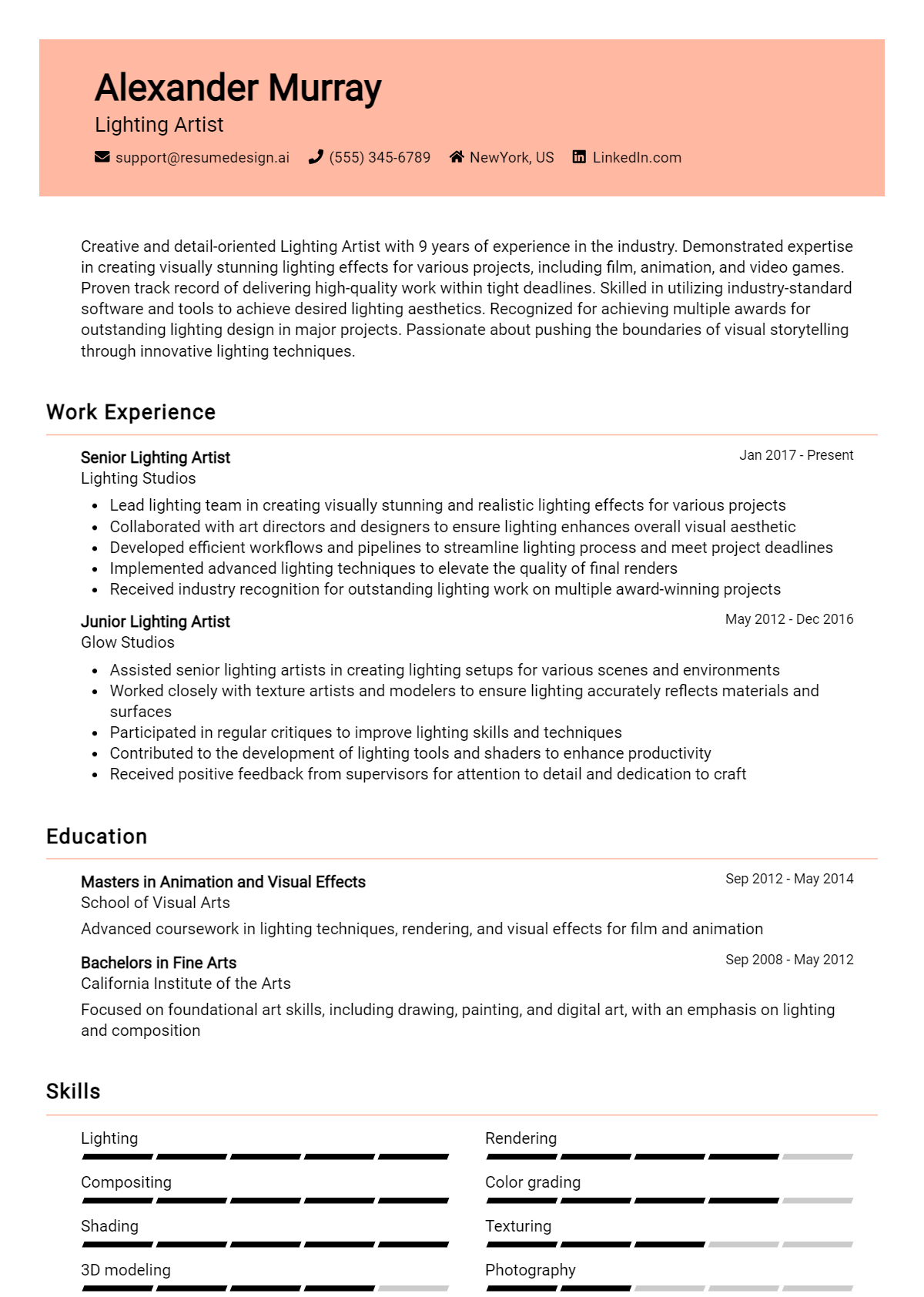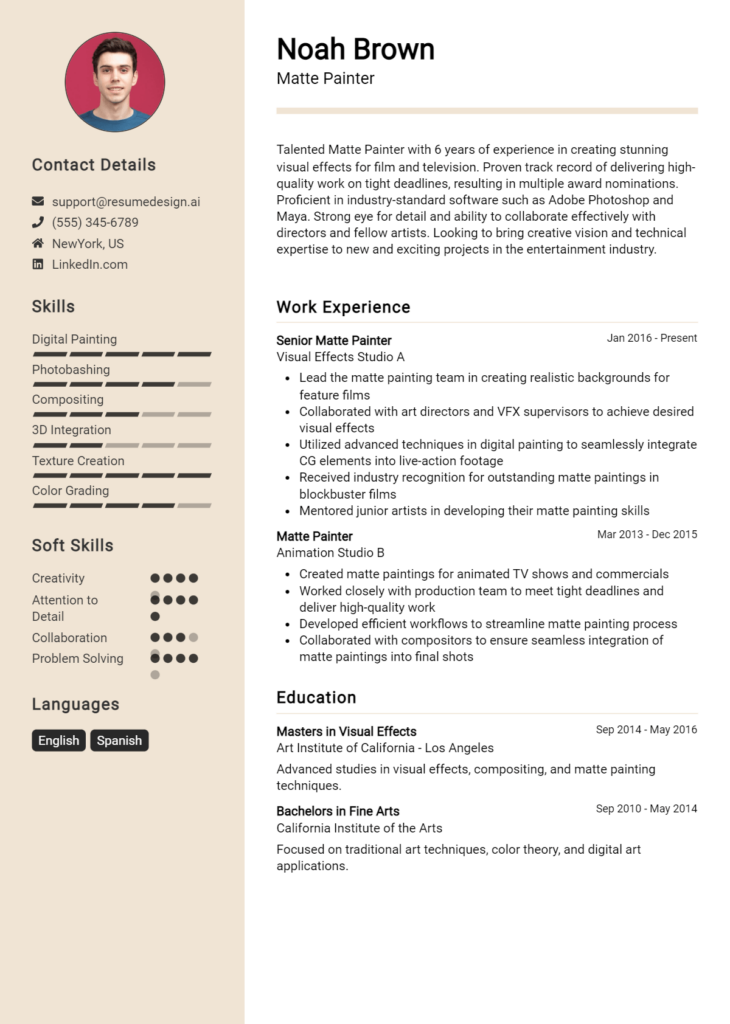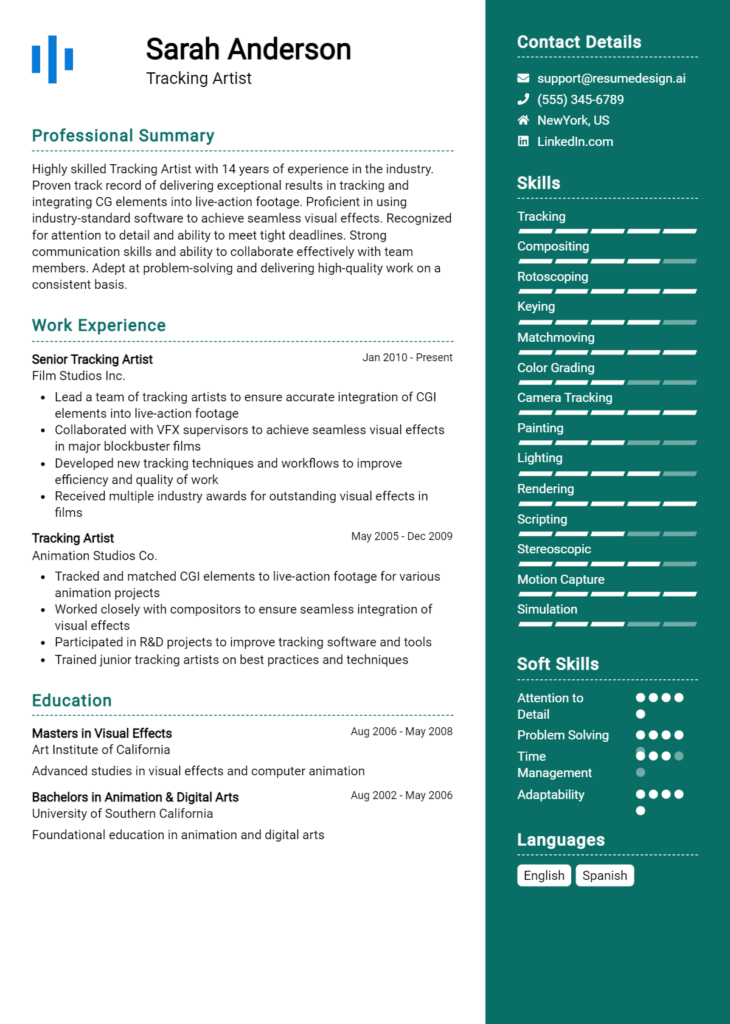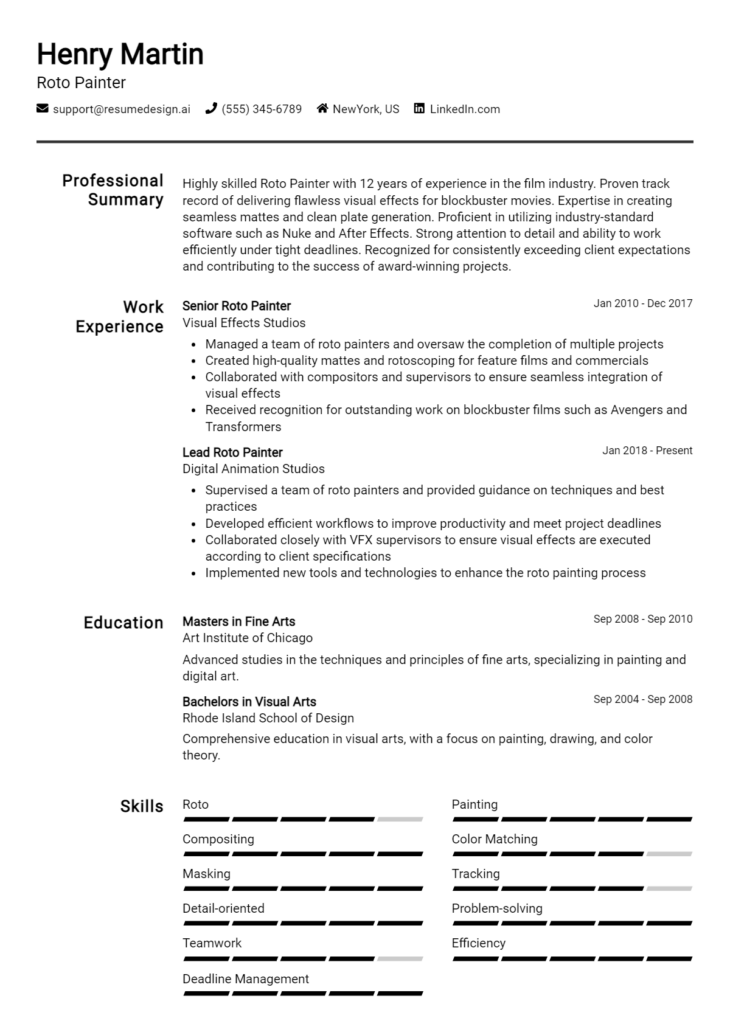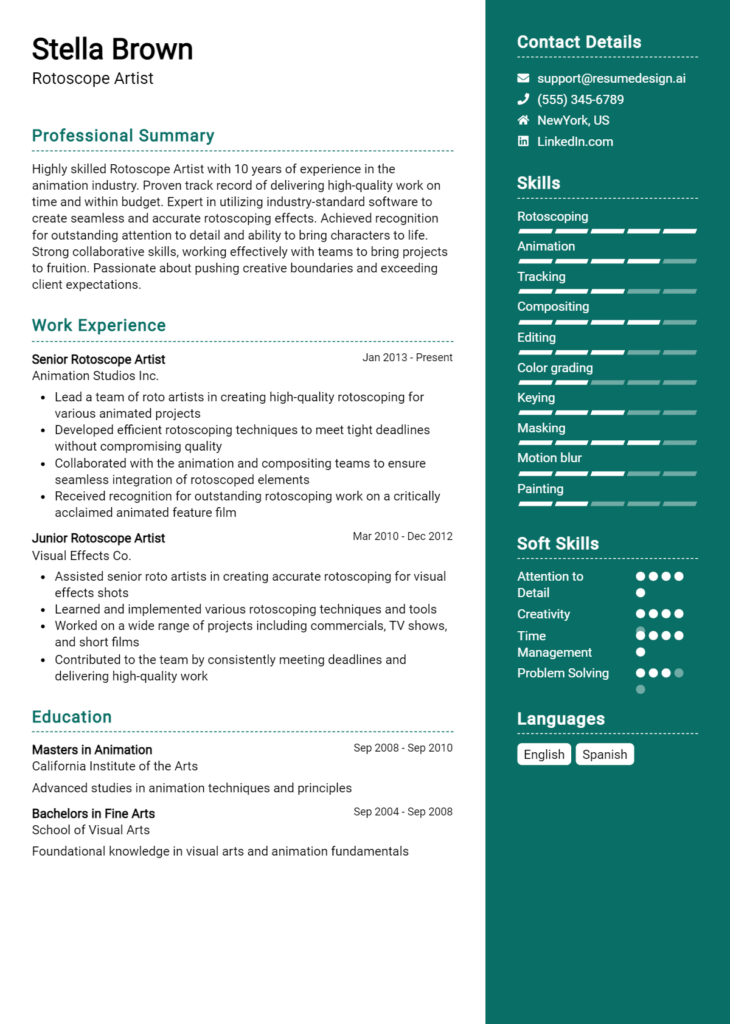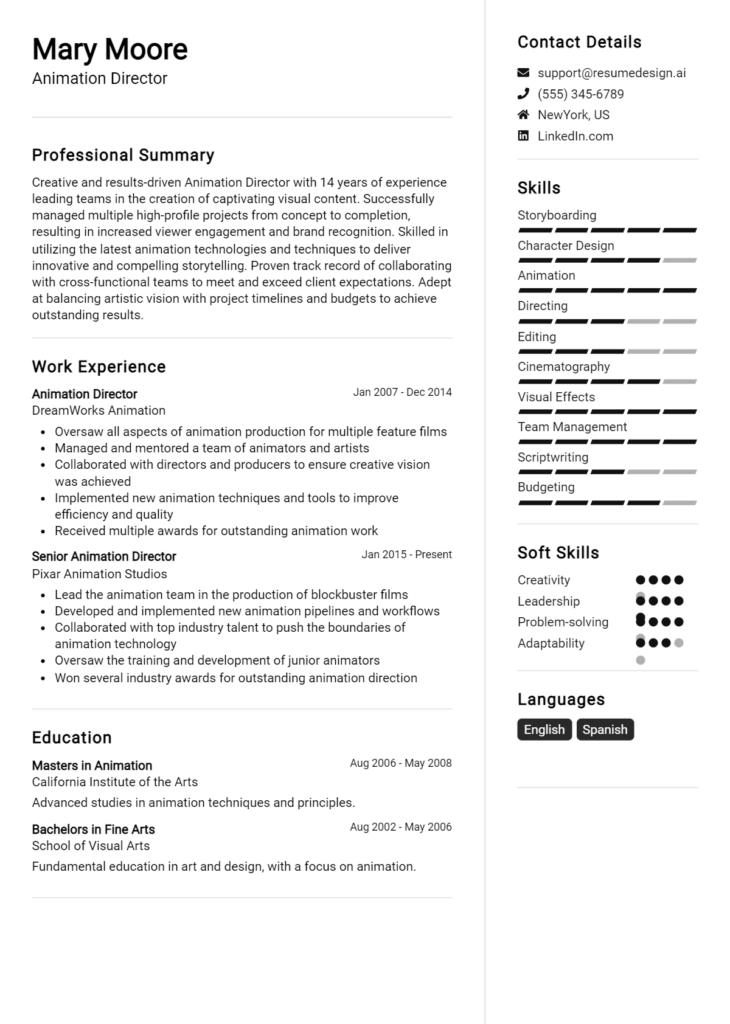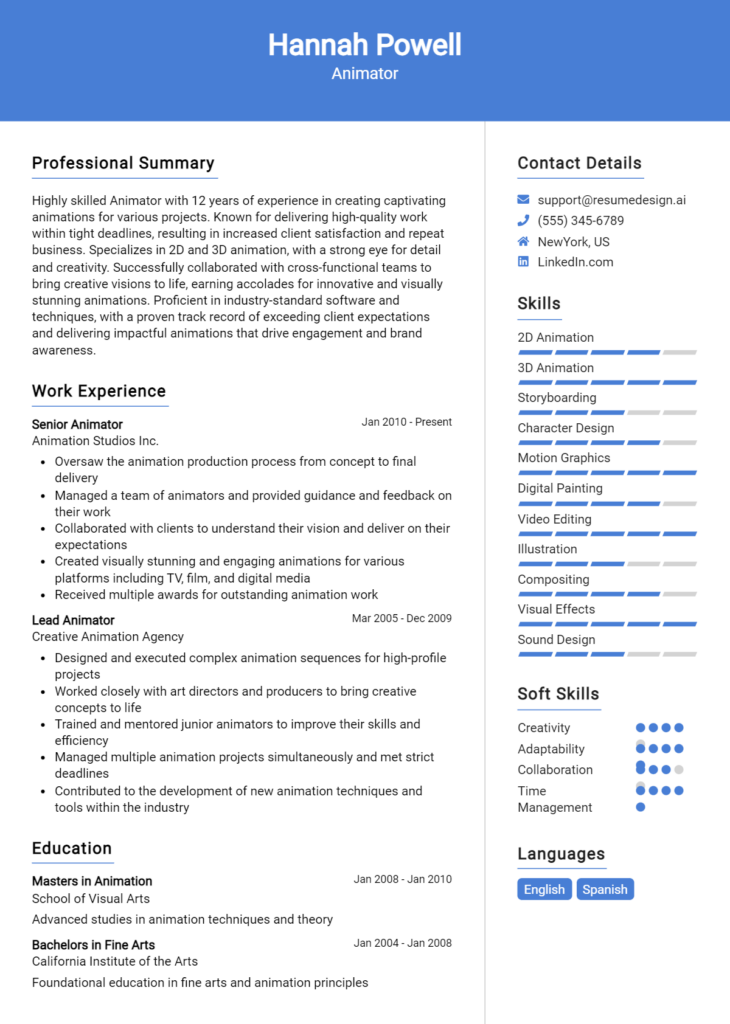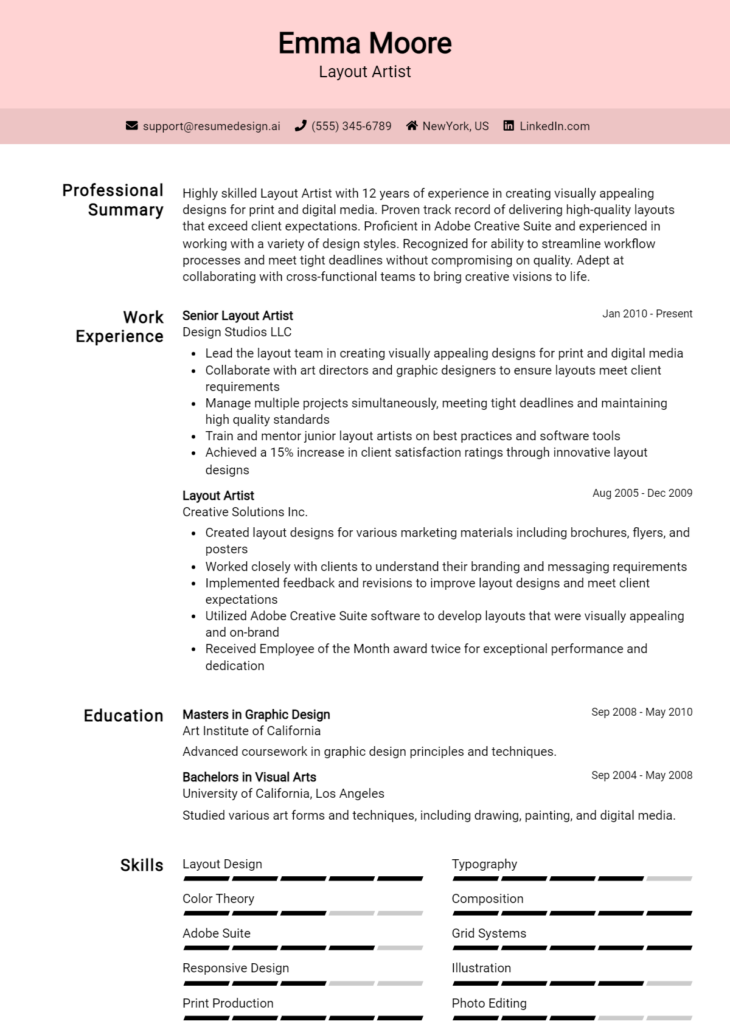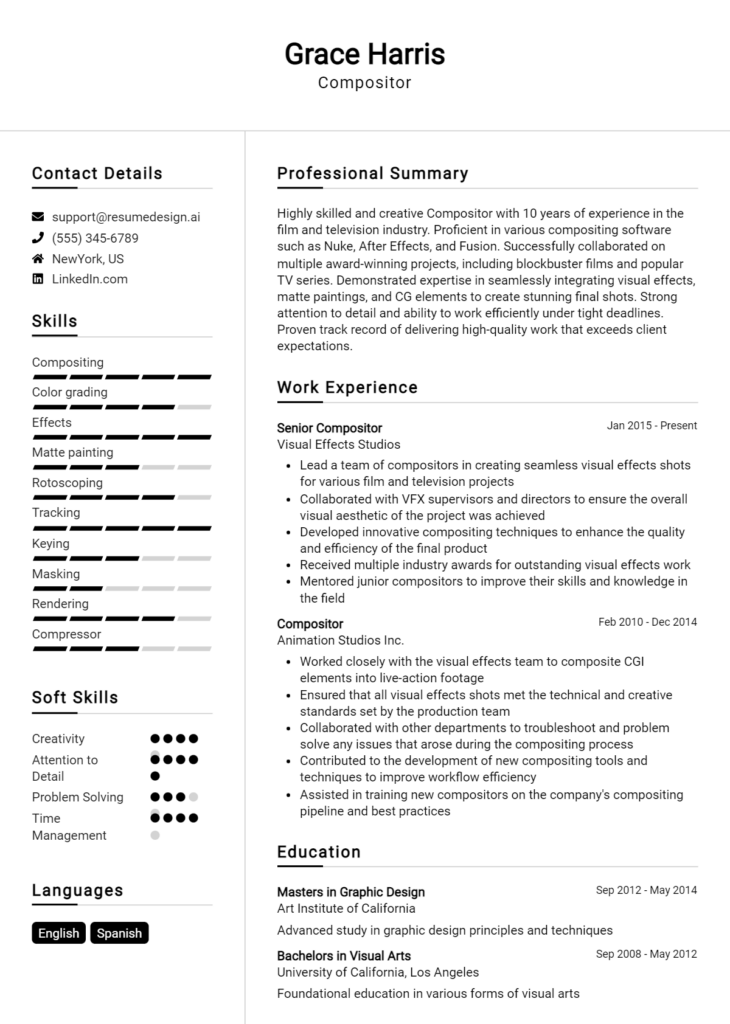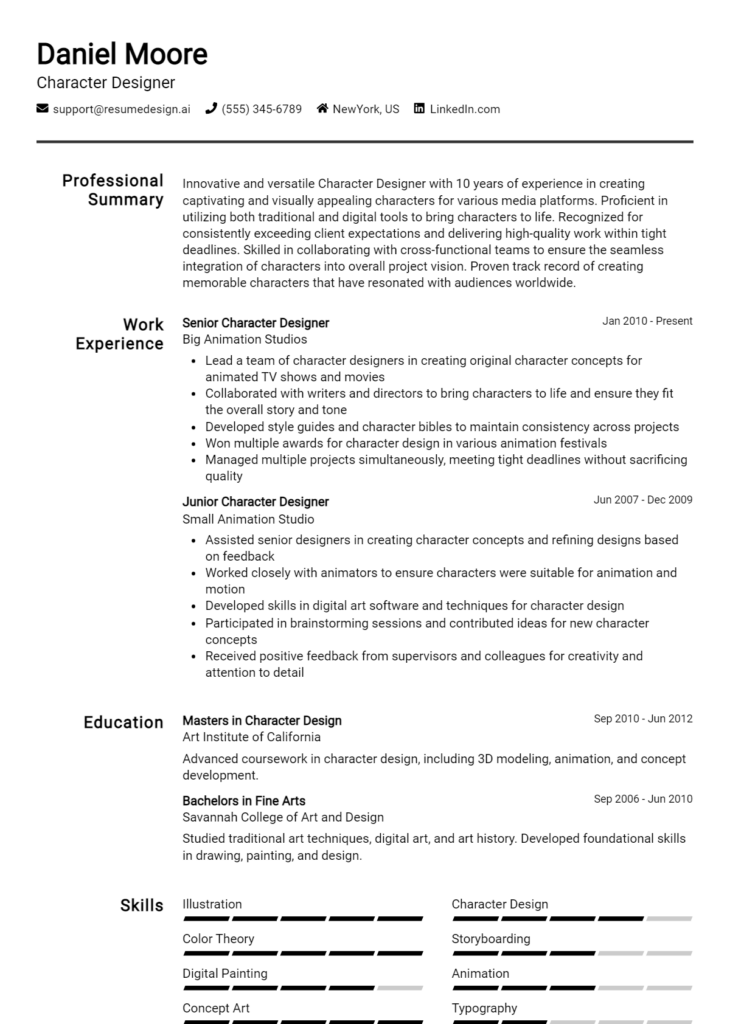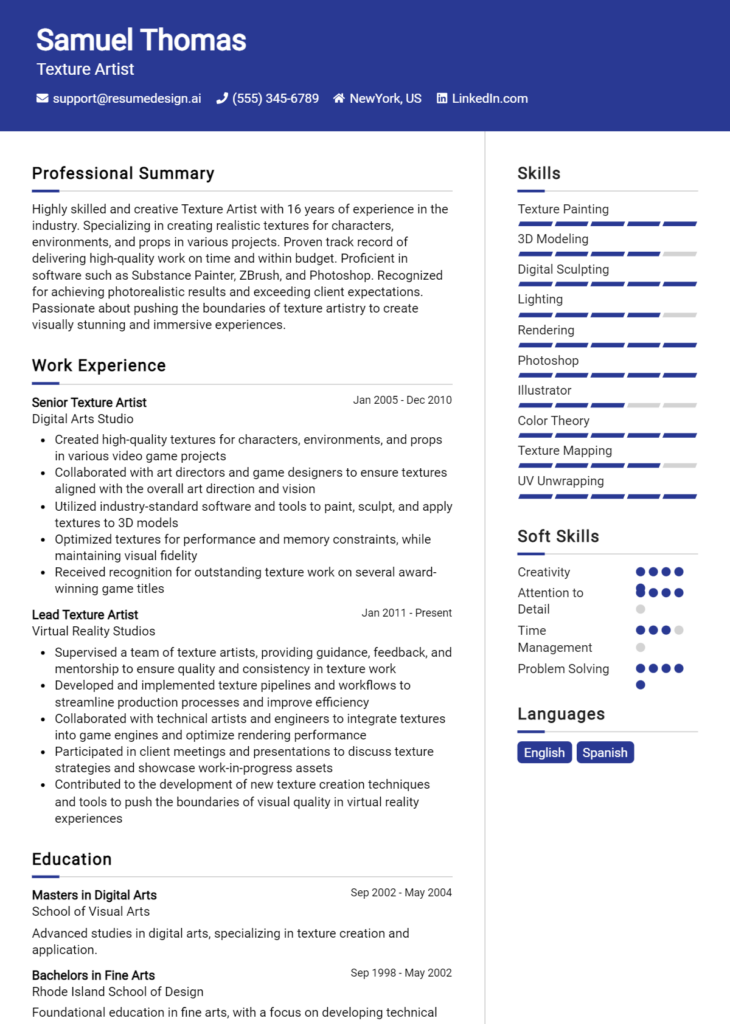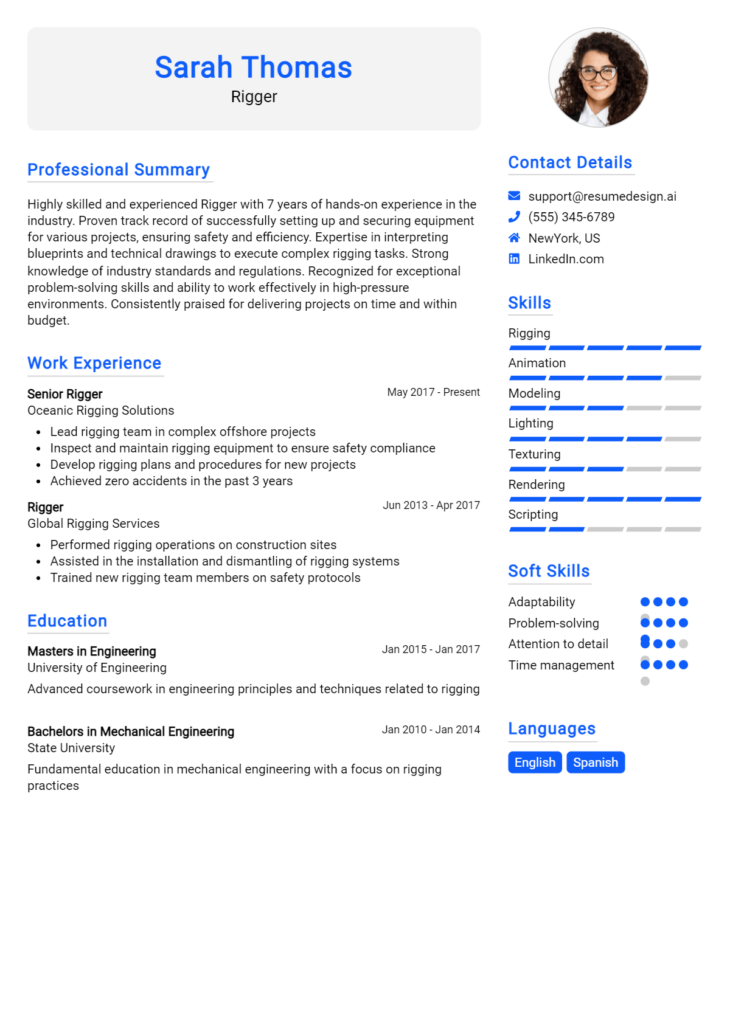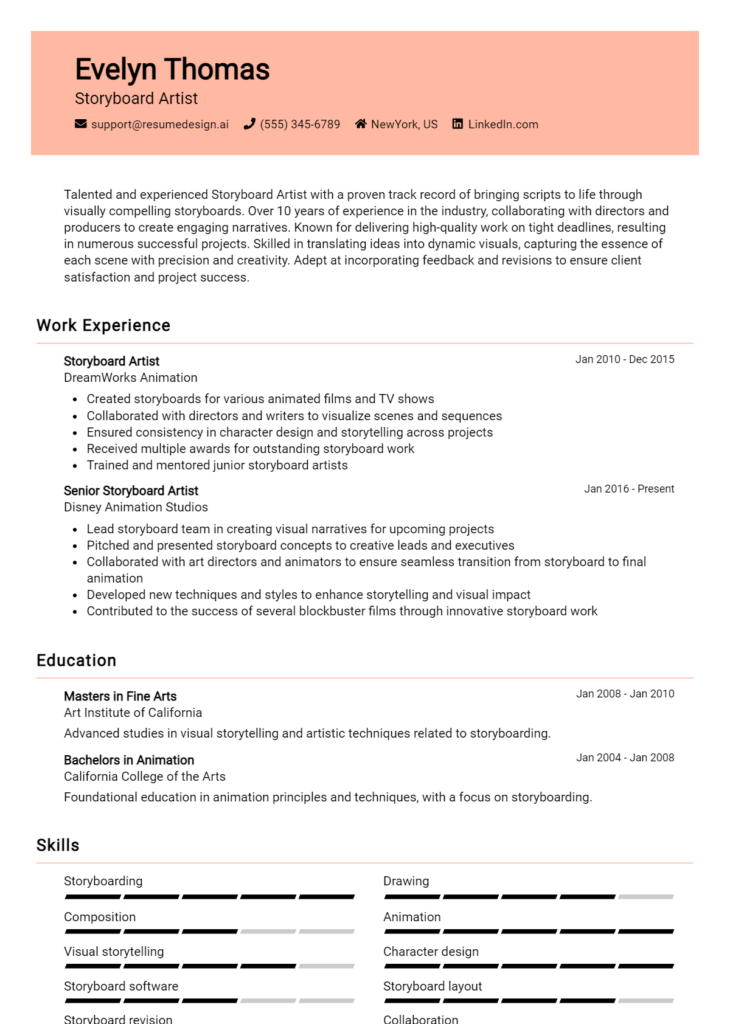Lighting Artist Core Responsibilities
A Lighting Artist plays a crucial role in visual storytelling, collaborating with various departments such as art, animation, and visual effects to create captivating environments through light. Essential skills include proficiency in lighting software, strong technical knowledge, and the ability to troubleshoot issues efficiently. Problem-solving and operational skills are vital for achieving the desired aesthetic while maintaining performance standards. A well-structured resume can effectively highlight these qualifications, showcasing a candidate's contribution to the organization's artistic vision.
Common Responsibilities Listed on Lighting Artist Resume
- Design and implement lighting setups for 3D scenes and environments.
- Collaborate with artists and technical teams to achieve desired visual effects.
- Ensure lighting consistency across various shots and sequences.
- Optimize lighting for performance and render times.
- Conduct lighting tests and adjustments based on feedback.
- Maintain an organized workflow and adhere to project deadlines.
- Stay updated with industry trends and software advancements.
- Provide technical support and guidance to junior artists.
- Document lighting setups and processes for future reference.
- Participate in creative discussions to enhance visual storytelling.
- Analyze and solve lighting-related problems during production.
High-Level Resume Tips for Lighting Artist Professionals
A well-crafted resume is crucial for Lighting Artist professionals, as it serves as the first impression a candidate makes on potential employers. In a highly competitive industry where visual storytelling and artistic vision are paramount, your resume needs to reflect not only your technical skills but also your unique achievements and contributions to past projects. A strong resume can effectively communicate your expertise in lighting design, showcasing your ability to enhance the aesthetic and emotional impact of visuals. This guide will provide practical and actionable resume tips specifically tailored for Lighting Artist professionals, helping you stand out in the job market.
Top Resume Tips for Lighting Artist Professionals
- Tailor your resume for each job application by incorporating keywords from the job description.
- Highlight relevant experience by using specific examples of projects you've worked on, including the types of lighting techniques employed.
- Quantify your achievements, such as the number of successful projects completed or any awards received for your lighting designs.
- Showcase industry-specific skills, including proficiency with lighting software and hardware, as well as an understanding of color theory and composition.
- Include a portfolio link that showcases your best work, demonstrating your range and creativity as a Lighting Artist.
- Utilize a clean, professional layout that enhances readability and emphasizes key information about your skills and experience.
- Incorporate testimonials or endorsements from previous employers or collaborators to add credibility to your skills and work ethic.
- Stay updated on industry trends and technologies, and mention any relevant courses or certifications that demonstrate your commitment to professional development.
- Use action verbs and concise language to clearly convey your impact and contributions in previous roles.
By implementing these tips, you can significantly increase your chances of landing a job in the Lighting Artist field. A well-structured and targeted resume not only showcases your technical abilities but also tells the story of your artistic journey, making you a compelling candidate for potential employers in the creative industry.
Why Resume Headlines & Titles are Important for Lighting Artist
In the competitive field of visual effects and animation, a Lighting Artist's resume must stand out to capture the attention of hiring managers. An impactful resume headline or title serves as a succinct summary of a candidate's key qualifications and expertise, allowing hiring professionals to quickly assess their fit for the role. A strong headline can immediately intrigue and engage a reader, often determining whether they delve deeper into the resume. It should be concise, relevant, and directly tied to the specific job being applied for, ensuring that the candidate's strengths are highlighted effectively from the outset.
Best Practices for Crafting Resume Headlines for Lighting Artist
- Keep it concise: Aim for a headline of no more than 10 words.
- Be specific: Use keywords that reflect the role and industry standards.
- Highlight key skills: Focus on the most relevant technical skills or software proficiency.
- Showcase experience: Incorporate years of experience or notable projects.
- Use action words: Start with strong verbs to convey competence and dynamism.
- Tailor for each application: Customize your headline to align with the job description.
- Avoid jargon: Ensure clarity by using language that is easily understood.
- Emphasize uniqueness: Include any specialized skills or achievements that set you apart.
Example Resume Headlines for Lighting Artist
Strong Resume Headlines
"Experienced Lighting Artist with 7+ Years in Film and Animation"
"Creative Lighting Specialist Proficient in Maya and Nuke"
"Award-Winning Lighting Artist | Expert in Realistic Renderings"
"Innovative Lighting Designer for Video Games with Proven Track Record"
Weak Resume Headlines
"Lighting Artist"
"Looking for a Job in Visual Effects"
"Just Another Lighting Artist"
The effectiveness of the strong headlines lies in their ability to convey specific skills, experience, and accomplishments, making them immediately relevant to potential employers. They provide a quick snapshot of what the candidate brings to the table, drawing the reader in. In contrast, the weak headlines fail to impress because they are generic and lack detail, offering no insight into the candidate's unique qualifications or value proposition. Such nondescript titles miss the opportunity to showcase the applicant's expertise, leading to a lack of interest from hiring managers.
Writing an Exceptional Lighting Artist Resume Summary
A well-crafted resume summary is crucial for a Lighting Artist as it serves as the first impression a hiring manager receives. An exceptional summary quickly captures attention by highlighting key skills, relevant experience, and notable accomplishments that align with the job role. It should be concise and impactful, tailored specifically to the position being applied for, thereby ensuring that the candidate stands out amidst a sea of applicants. A strong resume summary sets the tone for the rest of the application, making it an essential component for success in the competitive field of lighting design.
Best Practices for Writing a Lighting Artist Resume Summary
- Quantify Achievements: Use numbers to showcase the impact of your work, such as the percentage increase in visual quality or efficiency improvements.
- Focus on Skills: Highlight specific skills relevant to lighting design, such as proficiency in software like Maya, 3ds Max, or V-Ray.
- Tailor for the Job Description: Customize your summary to reflect the specific requirements and responsibilities listed in the job posting.
- Use Action Words: Start sentences with strong action verbs to convey your contributions effectively.
- Keep it Concise: Aim for 2-4 sentences that deliver maximum information in a digestible format.
- Showcase Industry Knowledge: Mention familiarity with industry trends and techniques to demonstrate your expertise.
- Highlight Team Collaboration: If applicable, indicate experience working in a team environment to emphasize your collaborative skills.
- Include Awards or Recognitions: If you have received any accolades or recognition in your field, mention them to bolster credibility.
Example Lighting Artist Resume Summaries
Strong Resume Summaries
Dynamic Lighting Artist with over 5 years of experience in the gaming industry, recognized for enhancing visual storytelling through innovative lighting techniques, resulting in a 30% increase in player engagement across multiple titles.
Detail-oriented Lighting Artist adept at utilizing V-Ray and Unreal Engine to create realistic lighting scenarios. Successfully led a team project that improved rendering speed by 25%, contributing to project delivery ahead of schedule.
Creative Lighting Artist with a proven track record of designing immersive environments for film and animation. Awarded 'Best Visual Effects' at the 2022 National Film Festival for outstanding lighting work on an animated short.
Skilled Lighting Artist specializing in both 3D and 2D projects, with expertise in color theory and composition. Enhanced the visual quality of a major feature film, resulting in a 15% increase in box office revenue.
Weak Resume Summaries
I am a Lighting Artist looking for a new opportunity to showcase my skills.
Experienced in lighting design and other aspects of production. I work well with teams.
The examples of strong resume summaries are considered effective because they provide specific, quantifiable results, showcase relevant skills, and directly relate to the role of a Lighting Artist. They highlight achievements and present a clear picture of the candidate's capabilities. In contrast, the weak summaries are vague and lack detail, offering no measurable outcomes or unique insights into the candidate's qualifications, which fails to engage hiring managers.
Work Experience Section for Lighting Artist Resume
The work experience section of a Lighting Artist resume is a critical component that highlights a candidate's technical skills, leadership abilities, and capacity to produce high-quality visual content. This section allows candidates to demonstrate their proficiency in lighting techniques, software, and tools relevant to the industry. By quantifying achievements—such as project timelines, budget management, and team performance—and aligning their experiences with industry standards, candidates can effectively communicate their value to potential employers. A well-crafted work experience section serves not only as a record of past employment but as evidence of a candidate's ability to contribute meaningfully to future projects.
Best Practices for Lighting Artist Work Experience
- Highlight specific lighting techniques and software proficiency relevant to the role.
- Quantify achievements with metrics such as project completion times, budget adherence, and audience engagement.
- Showcase collaboration with cross-functional teams, including directors, art teams, and technical staff.
- Detail any leadership roles or responsibilities, emphasizing team management and mentorship.
- Include any awards or recognitions received for lighting contributions in previous projects.
- Align your experience with industry standards and trends to show relevance and adaptability.
- Use action verbs to describe your contributions and impact on projects.
- Tailor your work experience to the specific job description, focusing on relevant projects and skills.
Example Work Experiences for Lighting Artist
Strong Experiences
- Led a team of 5 lighting artists in a feature film project, resulting in a 30% reduction in post-production time.
- Implemented innovative lighting techniques that enhanced the visual storytelling, contributing to a 15% increase in audience ratings.
- Collaborated with the art department to design lighting schemes for 10+ commercial projects, consistently meeting tight deadlines and exceeding client expectations.
- Managed a $200,000 budget for lighting equipment in a major production, achieving cost savings of 20% through strategic sourcing and planning.
Weak Experiences
- Worked on lighting for various projects.
- Assisted in setting up lighting equipment.
- Participated in team meetings regarding lighting design.
- Helped with lighting adjustments for a few scenes.
The examples provided illustrate the distinction between strong and weak experiences. Strong experiences are characterized by quantifiable outcomes, clear leadership roles, and significant contributions to projects, showcasing the candidate's expertise and impact. In contrast, weak experiences lack specificity, measurable achievements, and demonstrable skills, which do not effectively convey the candidate's value to potential employers.
Education and Certifications Section for Lighting Artist Resume
The education and certifications section of a Lighting Artist resume is crucial in establishing the candidate's academic background and technical proficiency in the field. This segment not only showcases relevant degrees and coursework but also emphasizes industry-recognized certifications and ongoing learning efforts that are vital for staying current in the fast-paced world of digital art and animation. By providing details on specific training and qualifications, candidates can greatly enhance their credibility and demonstrate their alignment with the requirements of the Lighting Artist role, making them more appealing to potential employers.
Best Practices for Lighting Artist Education and Certifications
- Include relevant degrees in fields such as Fine Arts, Animation, or Visual Effects.
- List industry-recognized certifications from reputable institutions or software providers.
- Highlight specific coursework related to lighting techniques, color theory, and rendering.
- Emphasize any advanced training in software like Maya, Blender, or Unreal Engine.
- Keep the section concise but detailed enough to showcase expertise.
- Use bullet points for clarity and easy reading of qualifications.
- Update the section regularly with new certifications or courses completed.
- Tailor the education and certifications to align with the specific job description of the role being applied for.
Example Education and Certifications for Lighting Artist
Strong Examples
- Bachelor of Fine Arts in Animation, University of California, Los Angeles (Graduated 2022)
- Certified Lighting Artist, Academy of Digital Arts (2023)
- Advanced Lighting Techniques Course, School of Visual Effects (Completed 2021)
- Certificate in 3D Rendering and Lighting, Coursera (Completed 2023)
Weak Examples
- Associate Degree in General Studies, Community College (Graduated 2018)
- Certification in Basic Microsoft Office Skills (Completed 2020)
- High School Diploma, Local High School (Graduated 2016)
- Introductory Photography Course, Unaccredited Online School (Completed 2019)
The strong examples are considered relevant and impactful because they are directly aligned with the skills and knowledge necessary for a Lighting Artist, showcasing both formal education and specialized training. In contrast, the weak examples lack relevance to the position, focusing on general or outdated qualifications that do not pertain to lighting or visual arts, which diminishes the candidate's potential appeal to employers in the industry.
Top Skills & Keywords for Lighting Artist Resume
As a Lighting Artist, your resume serves as a crucial tool in showcasing your abilities and expertise to potential employers. In an industry driven by visuals, the right skills can make a significant difference in how your work is perceived. Highlighting both your hard and soft skills effectively demonstrates your technical proficiency, creativity, and collaborative capabilities. A well-crafted resume that emphasizes these skills not only captures attention but also reflects your understanding of the role's demands. To ensure you stand out in a competitive field, it’s essential to include a comprehensive list of skills that align with the expectations of the position.
Top Hard & Soft Skills for Lighting Artist
Soft Skills
- Strong communication skills
- Team collaboration
- Problem-solving abilities
- Attention to detail
- Time management
- Creativity
- Adaptability
- Flexibility under pressure
- Critical thinking
- Open-mindedness to feedback
Hard Skills
- Proficiency in lighting software (e.g., Maya, Blender, 3ds Max)
- Understanding of color theory
- Knowledge of rendering techniques
- Familiarity with compositing software (e.g., Nuke, After Effects)
- Experience in creating light rigs
- Ability to simulate natural and artificial lighting
- Knowledge of industry-standard pipelines
- Skills in texture and shading
- Familiarity with VRay or Arnold
- Understanding of cinematography principles
By emphasizing these skills in your resume, along with relevant work experience, you can effectively showcase your qualifications as a Lighting Artist and increase your chances of landing the desired position.
Stand Out with a Winning Lighting Artist Cover Letter
Dear [Hiring Manager's Name],
I am writing to express my enthusiasm for the Lighting Artist position at [Company Name] as advertised on [where you found the job listing]. With a solid background in visual storytelling and a passion for creating immersive environments through light, I believe I would be a valuable asset to your talented team. My experience in both traditional and digital mediums has equipped me with a diverse skill set, allowing me to illuminate scenes in ways that enhance mood, depth, and narrative.
During my time at [Previous Company Name], I successfully contributed to multiple projects by implementing innovative lighting techniques that not only elevated the visual quality but also aligned with the artistic vision of the team. My proficiency in software such as Maya, Blender, and Unreal Engine has enabled me to create dynamic lighting setups that engage audiences and serve the story. I am particularly proud of my work on [specific project or game], where I collaborated closely with designers and directors to ensure that the lighting complemented the overall aesthetic, resulting in a final product that received critical acclaim.
I am drawn to [Company Name] because of your commitment to pushing the boundaries of visual technology and storytelling. I admire the unique approach your team takes to create memorable experiences, and I am eager to contribute my skills in lighting design to help achieve this vision. I am confident that my creativity, attention to detail, and collaborative spirit will make a positive impact on your upcoming projects.
Thank you for considering my application. I look forward to the opportunity to discuss how my background, skills, and enthusiasms align with the goals of [Company Name]. I am excited about the possibility of contributing to your team and helping to produce captivating visual narratives that resonate with audiences worldwide.
Sincerely,
[Your Name]
[Your Contact Information]
[Your LinkedIn Profile or Portfolio Link]
Common Mistakes to Avoid in a Lighting Artist Resume
When crafting a resume as a Lighting Artist, it's crucial to present your skills and experiences in a way that resonates with potential employers. However, many candidates make common mistakes that can detract from their overall appeal. Avoiding these pitfalls can significantly enhance your chances of showcasing your expertise effectively. Here are some common mistakes to steer clear of when creating your Lighting Artist resume:
Neglecting to Showcase a Portfolio: Failing to include a link to an online portfolio can leave employers without a clear understanding of your work and capabilities. Always provide easy access to your best projects.
Using Generic Job Descriptions: Simply listing job duties from previous positions without tailoring them to your specific achievements can make your resume blend in with others. Focus on what you accomplished in those roles.
Ignoring Technical Skills: Lighting Artists rely heavily on specific software and technologies. Omitting relevant tools like Maya, Blender, or Unreal Engine can make your resume less competitive.
Lack of Visualization: A resume that is text-heavy and lacks visual elements can be less engaging. Consider using subtle design elements that reflect your artistic sensibilities without overshadowing the content.
Forgetting to Highlight Collaboration Skills: Lighting Artists often work in teams. Not mentioning your ability to collaborate with other departments, such as modeling or cinematography, may give the impression you work best in isolation.
Overloading with Jargon: While technical terms are essential, using too much industry jargon can alienate hiring managers who may not be familiar with every term. Strive for a balance that maintains professionalism without overwhelming the reader.
Ignoring Industry Trends: Not staying updated with the latest trends and techniques in lighting can make your skills seem outdated. Highlight any recent training or knowledge of current practices to show you are relevant.
Submitting a One-Size-Fits-All Resume: Using the same resume for every application can be detrimental. Tailor your resume to each job description, emphasizing the skills and experiences that align most closely with the specific role.
Conclusion
As a Lighting Artist, your role is crucial in bringing visual narratives to life through the effective use of light, shadow, and color. You are responsible for enhancing the mood, atmosphere, and overall aesthetics of a scene, whether in film, video games, or animation. Understanding the principles of lighting design, mastering various software tools, and collaborating closely with directors and other artists are key elements of your job. Additionally, staying updated with industry trends and continuously honing your skills can set you apart in this competitive field.
In conclusion, to ensure that your resume accurately reflects your skills and experiences as a Lighting Artist, consider reviewing and updating it regularly. A well-crafted resume can make a significant difference in landing your dream job. To assist you in this process, explore the variety of resources available, including resume templates, a user-friendly resume builder, insightful resume examples, and professional cover letter templates. Take action today to enhance your job application materials and showcase your talent effectively!

